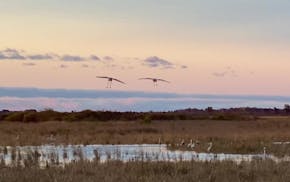An "emblem of motion and power — pulse of the continent." That's how Walt Whitman described a train speeding through a snowstorm in "To a Locomotive in Winter," a poem that thrills to the vehicle's "fierce-throated beauty" and clamorous power.
Whitman wrote the poem after rushing from New York City to Washington, D.C., during the Civil War, relying on the fastest conveyance possible in his day. He'd just learned that his brother George had been wounded at the Battle of Fredericksburg.
I traversed the same territory in reverse, riding from the capital to New York City aboard Amtrak's Acela on a recent wintry afternoon, and I quickly understood Whitman's reaction. My ride, too, combined beauty and exhilaration.
And speed. The Acela Express is the nation's fastest train, maxing out at 150 miles per hour and covering the trip's 226 miles in two hours, 45 minutes.
To do that by car, you'd need to average 82 miles per hour. Good luck with that.
The East Coast's time-distance-cost-hassle travel equation is different from the Midwest, where bullet trains, including one between Chicago and the Twin Cities, remain a distant dream. In the busy northeast corridor, Amtrak has established itself as a major player for people frazzled by airport security lines, but still in a hurry.
In the 13 years since high-speed Acela trains began operating between Washington, D.C., and Boston, they have captured a hefty share of business and pleasure travel. Capacity and ridership have risen, and the trains are often fully booked.
Perks of riding the rails
It's not that train travel is always cheaper. In fact, coach airfares often run less than a business-class round trip on the Acela. (Coach seats on Amtrak's Northeast Regional run are cheaper, but that train's D.C.-New York trip has more stops and takes 3 hours and 25 minutes.)
Amtrak uses other come-ons to lure Acela riders: hourly departures, travel times under three hours, Quiet Cars, Wi-Fi, seats more spacious and comfortable than some airline's first-class offerings and a cafe car. In first class, servers bring food and drinks to riders at their seats.
Another consideration is that most stations on the train's route are downtown and connected to transit. So long, pricey cab rides to and from the airport.
Trains, like planes, do not always run on time. My 9 a.m. weekday train from Washington was canceled due to weather (single-digit temperatures, about 8 inches of snow in New York). Amtrak alerted me by e-mail the night before. After 35 minutes on hold, an operator said she could get me on the 1 p.m. Acela.
For a sense of history and occasion, no airport on Earth can rival the imposing pile of Vermont granite that is architect Daniel Burnham's Union Station in Washington. Soldiers and presidents, clerks and queens all have passed between its towering, sculpture-topped columns and beneath its elegant archways.
A crowd lined up outside the F Gate for the 1 p.m. Acela, but we moved on board quickly. The trains have locomotives at front and back, with six passenger cars between them. One is first class, one the cafe car, the rest business class.
Soothing hush of Quiet Car
I found the last window seat in what turned out to be the Quiet Car, where cellphone use is prohibited and riders are encouraged to speak in hushed tones. Sort of like a library reading room, if such a room could be transported from D.C. to Baltimore in 38 minutes.
Engineered with a lowered center of gravity to mitigate sway on turns, the train has a surprisingly smooth ride, even at top speeds.
Like a fast-cut movie, the afternoon whizzed past the big windows in rich variety: snow-filled woods, ice-edged streams, back yards, barns, bridges, billboards, graffiti, smokestacks with their fallen-hero steam clouds, wide silvery expanses of Chesapeake Bay, shipyards, junkyards, a depressed row house neighborhood in Baltimore that was right off the set of "The Wire."
There were the massed buildings of Johns Hopkins University, and later, Philadelphia's glass-tower skyline.
A surge of Philly riders, their coats throwing off a wintry cold, boarded. Two empty seats near me were taken. Suddenly, a lazy afternoon of window-staring and daydreaming took on a more hectic, hurried tone. We were just 75 minutes from New York.
Even a fast train ride offers glimpses of the landscape, sights more intimate than are possible from the air. Two children hop off a yellow bus. A couple enter the Colonia Elks Lodge in New Jersey.
Seasoned passengers rarely looked outside, preferring the stimulation of their screens and devices. But even with a good book on board, I couldn't take my eyes off the passing picture show.
We slowed on the approach to Newark and I saw the far-off, sun-catching sides of One World Trade Center in Lower Manhattan, a favorite stamping ground of poet and train lover Walt Whitman.
Claude Peck • 612-673-7977 • On Twitter: @ClaudePeck

Want to share info with the Star Tribune? How to do it securely

A Minnesota field guide to snow shovels: Which one's best?
Sign up for Star Tribune newsletters
